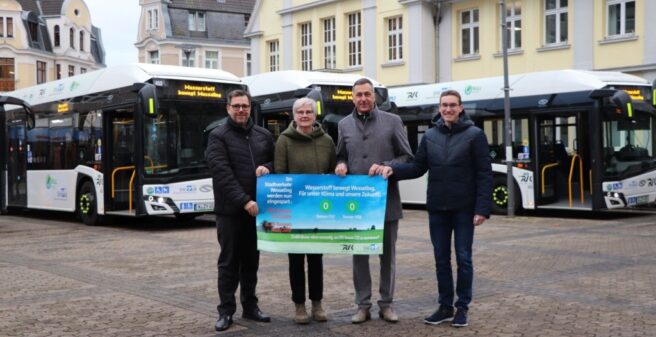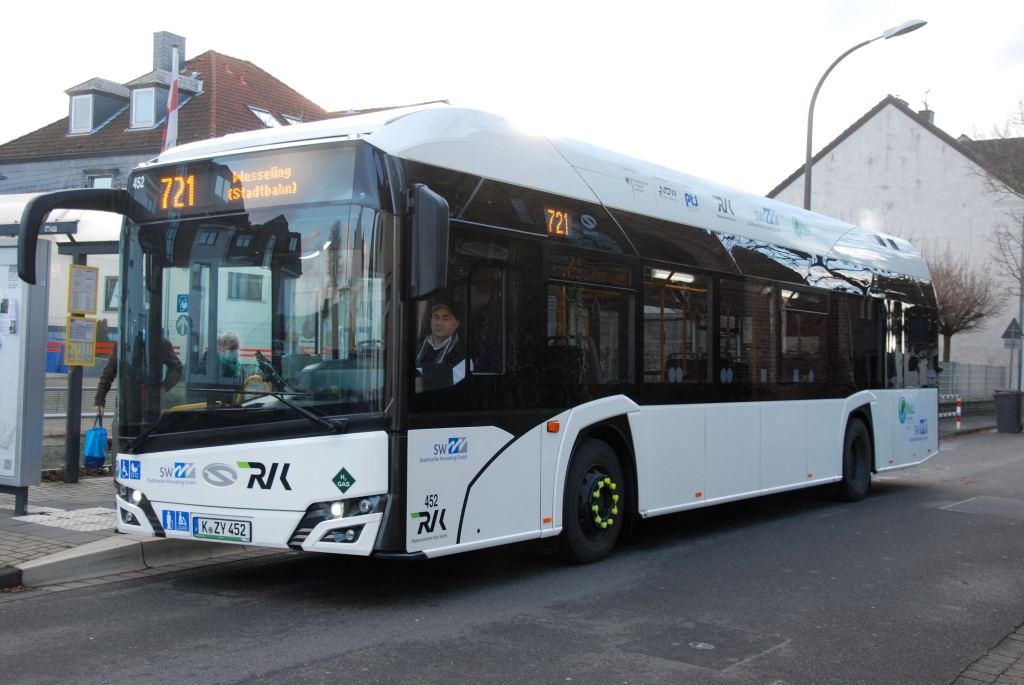
On the left bank of the Rhine, between the larger cities Cologne and Bonn you will find the medium-size town of Wesseling with just under 40,000 inhabitants.
Wesseling was connected to the railway network as early as 1906 with the “Rheinuferbahn” of the Köln – Bonner Eisenbahnen (KBE). The Rheinuferbahn was an unusual private railway: right from the start it was a high-speed line on standard gauge, unlike its KBE sister, the originally metre-gauge “Vorgebirgsbahn”, which was (only) converted to standard gauge from Bonn in 1929. The nearest station of the state-owned railway to Wesseling was (and still is) in Brühl, five kilometres away on the Cologne – Bonn – Koblenz line.
After the Second World War, the KBE also set up bus lines, for example one that connected the neighbouring towns of Wesseling and Brühl. And both towns also got inner-city lines. During the short time that Wesseling belonged to Cologne, buses of the Cologne KVB operated here. Around 1990, the KBE bus service was discontinued. The lines were taken over by Regionalverkehr Köln (RVK), the younger buses went to Cologne’s KVB, while the older coaches were sold to private bus companies.
Since 1998, Stadtwerke Wesseling GmbH (SWW) has operated the two Wesseling city lines 721 (from the city centre (Stadtbahn) to the Urfeld district) and 723 (from the city centre (Stadtbahn) to the Keldenich district). SWW does not have its own buses; RVK buses are used. Four buses are used in peak traffic, a fifth is available as a reserve. Buses in Wesseling’s urban transport system were diesel buses until just now.

Five fuel cell buses from Solaris
This has now changed with the new year. On 9 January 2023, SWW proudly presented five 12-metre-long fuel cell Solaris – of the type “Solaris Urbino 12 hydrogen” – which RVK purchased especially for use in Wesseling. Accordingly, they not only bear the RVK logo, but also that of SWW.
The procurement was preceded by a test run of four hydrogen buses from March 2022, which were provided by RVK and came from other RVK depots. And this test operation convinced the SWW management – and, as SWW emphasise, also the citizens of the city.
The five Solaris Urbino 12 hydrogen buses will be refuelled in Wesseling at the Shell filling station in Ahrstraße. This station already offered hydrogen for cars, but now it is also possible to refuel the city buses. While a car takes its hydrogen on board at a pressure of 700 bar, a bus only needs 350 bar. SWW emphasises that a refuelling process with hydrogen does not take longer than a refuelling process with diesel. – One tank of hydrogen gives the bus a range of 350 kilometres, which is as far as a diesel bus can go. So: refuelling (recharging) during the day while the bus is in use on the route is absolutely superfluous.
And so that the driver always knows how far the tank will last, there is an instrument in the dashboard that shows him exactly that. It says, for example: 230 kilometres.
The procurement of the fuel cell buses was made possible by a grant from the BMDV (Federal Ministry for Digital Affairs and Transport), which RVK received.
Advantages of the fuel cell buses
Stadtwerke Wesseling: “Hydrogen-powered fuel cell hybrid buses score in many respects. On site, they cause no emissions whatsoever – apart from absolutely harmless water vapour. They are much quieter than diesel buses and release neither NOx (nitrogen) nor CO2 (carbon dioxide). Compared to modern diesel buses with Euro 6 engines, 295 tonnes of CO2 and 0.36 tonnes of NOx are not released into the atmosphere. It would take 23,600 trees to compensate for the 295 tonnes of CO2!”
RVK still operates Europe’s largest fleet of hydrogen buses. And it has been doing so since 2014 – if you count the two APTS Phileas, even since 2011.
More about the RVK’s hydrogen buses here in another report:
https://www.urban-transport-magazine.com/en/rvk-cologne-and-its-history-of-its-hydrogen-buses/

